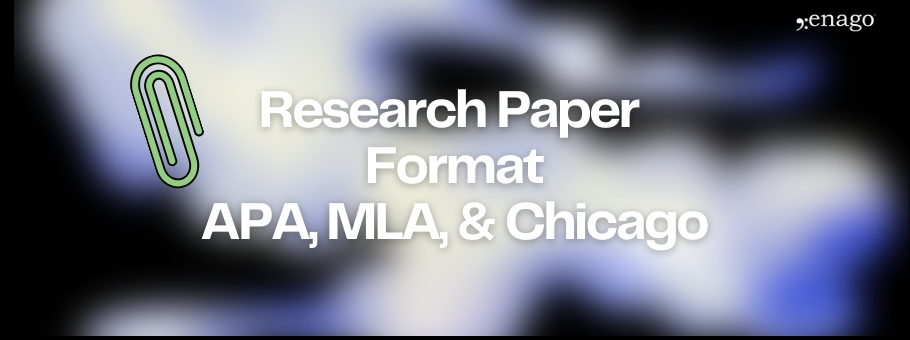Research Paper Format: APA, MLA, and Chicago Explained

When preparing a research paper, following the correct formatting is crucial for academic success. Whether you’re drafting a research paper, thesis, or journal article, using the right research formatting ensures clarity, professionalism, and compliance with academic standards. In this guide, we’ll dive into the essentials of APA, MLA, and Chicago styles, providing you with the tools you need to format your paper with confidence and precision.
Why Research Paper Formatting is Essential
Effective research formatting plays a crucial role in the readability, credibility, and acceptance of your paper. Whether submitting to a peer-reviewed journal or preparing your thesis for submission, adhering to the correct formatting style ensures that your paper meets institutional and publishing standards.
APA, MLA, and Chicago styles are commonly used in academic writing. Choosing the right style for your discipline helps you present your research in a structured, professional manner, increasing the likelihood of publication success. Ensuring consistency in citations and references is key to maintaining academic writing integrity.
Overview of Major Research Paper Formats
Three primary citation styles dominate academic writing: APA, MLA, and Chicago. Understanding these formats is essential for researchers in different fields. Each style has specific characteristics and applications, which we’ll explore here.
1. APA Style: Preferred in the Social Sciences
The American Psychological Association (APA) style is the standard formatting style used in social sciences like psychology, sociology, and education. It emphasizes clarity and accessibility, making it ideal for presenting data-driven research.
Key Features of APA Style:
- Title Page: A separate title page is required, which includes the title of your research paper, the author’s name, institutional affiliation, course details, and instructor’s name. Professional papers also require a running head and page numbers.
- In-text Citations: APA citations use the author-date format (e.g., Smith, 2021).
- References List: A separate “References” section includes all cited sources in alphabetical order, formatted with a hanging indent.
APA 7th Edition Updates:
- Student Paper Formatting: Running heads are no longer required for student papers, making the formatting simpler.
- Multiple Authors: APA 7 allows the citation of up to 20 authors in the reference list (previously only seven).
- Bias-Free Language: Emphasis on using inclusive language to avoid bias.
- Multimedia Citations: Updates to the guidelines for citing social media posts, podcasts, and other online resources.
Example of APA Citation:
In-text: (Brown, 2023, p. 45)
Reference: Brown, J. (2023). An introduction to research methodologies. Academic Publishers.
2. MLA Style: Ideal for Humanities
The Modern Language Association (MLA) style is predominantly used in humanities disciplines, such as literature, history, and cultural studies. It is favored for its simplicity, particularly for textual analysis and citation of primary sources.
Key Features of MLA Style:
- Title Page: MLA does not require a title page. Instead, the author’s name, course, instructor, and date appear on the first page, above the title.
- In-text Citations: The author-page format is used (e.g., Smith 45).
- Works Cited: A “Works Cited” page at the end of the paper lists all the sources you referenced, formatted according to MLA guidelines.
Recent Updates in MLA:
- Citing Digital Sources: MLA has expanded its guidelines to address how to cite online materials such as websites, social media posts, and digital archives.
- Simplified Formatting: Updates have streamlined formatting for various types of documents, including essays and research papers.
Example of MLA Citation:
In-text: (Wilson 23)
Works Cited: Wilson, James. American Literature and Culture. Cambridge University Press, 2021.
3. Chicago Style: Comprehensive and Flexible
The Chicago Manual of Style offers two citation systems: Notes and Bibliography (commonly used in humanities) and Author-Date (more frequent in the sciences).
Key Features of Chicago Style:
- Citation Systems:
- Notes and Bibliography: Uses footnotes or endnotes for citation.
- Author-Date: Similar to APA style citation, it uses in-text citations (author-date format).
- Formatting: Includes a detailed title page, double-spaced text, and uniform margins.
- Bibliography: A comprehensive list of all sources referenced in the research paper.
Expanded Coverage of Chicago Style:
- Notes and Bibliography: This system is typically used in history, literature, and the arts, where primary sources and detailed notes are crucial.
- Author-Date: Often used in scientific writing, where clear citation of sources is essential.
Example of Chicago Citation:
Footnote: John L. Smith, Exploring History (New York: Oxford University Press, 2020), 26.
Bibliography: Smith, John L. Exploring History. New York: Oxford University Press, 2020.
APA vs. MLA vs. Chicago: Key Differences
| Feature | APA | MLA | Chicago |
|---|---|---|---|
| Disciplinary Use | Social sciences | Humanities | History, anthropology, sciences |
| In-text Citation | Author-date (e.g., Smith, 2021) | Author-page (e.g., Smith 45) | Notes-Bibliography or Author-Date |
| Title Page | Separate page | Not required | Separate and detailed title page |
| Reference Section | “References” | “Works Cited” | “Bibliography” or “References” |
| Complexity | Moderate | Simplest | Detailed yet flexible |
How to Choose the Right Formatting Style
Choosing the right citation format depends on several factors:
- Academic Discipline: APA style is preferred for social sciences, while MLA is commonly used in humanities. Chicago style is versatile, suitable for both humanities and scientific fields.
- Publication Requirements: Always consult the journal or publisher’s submission guidelines to determine their preferred style. This can save time and ensure your work is considered.
- Readability Needs: If your work involves empirical research or statistical analysis, APA citations offer a structured approach. MLA is ideal for literary or historical analysis, while Chicago style provides flexibility across different fields.
Common Formatting Mistakes and How to Avoid Them
Even experienced researchers face challenges with formatting. Here are some common mistakes and tips to avoid them:
- Inconsistent Citations: Always ensure that your in-text citations match the entries in your reference list.
- Outdated Formatting: Stay updated with the latest editions of your style guide (e.g., APA 7, MLA 9, or the latest Chicago style edition).
- Incorrect References: Use citation management tools, but manually verify that your references are correct.
If you need additional help with formatting, Enago’s services can assist with ensuring your paper follows the correct guidelines, enhancing its chances for publication.
Additional Resources:
- Purdue OWL: A comprehensive guide for APA, MLA, and Chicago style citations.
- APA Style Official Website: The most authoritative resource for APA formatting and citation rules.
- Chicago Manual of Style: A great resource for both the Notes and Bibliography and Author-Date citation styles.
Conclusion
Mastering research paper formatting is an essential skill for academic success. By understanding the nuances of APA, MLA, and Chicago style citations, you can ensure that your research is well-presented and adheres to academic standards. Whether you’re preparing a paper for publication or a thesis for submission, proper formatting ensures that your work is professional and credible. Enago’s services are here to assist with perfecting your formatting, ensuring that your research meets all academic guidelines.
Frequently Asked Questions
What are the key differences between APA, MLA, and Chicago styles for academic writing?▼
APA, MLA, and Chicago styles differ in their citation and formatting approaches. APA is used in social sciences, MLA in humanities, and Chicago offers two systems: Notes and Bibliography and Author-Date. APA requires a title page and author-date citations, MLA uses author-page citations without a title page, and Chicago offers more flexibility with footnotes and bibliographies.
How do I choose the right citation style for my research paper?▼
Choosing the right citation style depends on your discipline, paper type, and submission guidelines. APA is ideal for social sciences, MLA for humanities, and Chicago for flexible use in history, literature, or scientific research. Always check the specific requirements of your institution or journal before deciding.
What are common mistakes to avoid when formatting research papers?▼
Common formatting mistakes include inconsistent citations, outdated citation styles, and incorrect reference formatting. To avoid these, stay updated with the latest editions of APA, MLA, or Chicago guides, use citation management tools, and carefully proofread references and citations to ensure accuracy.
How do I format my research paper according to APA guidelines?▼
APA formatting requires a title page with specific details, in-text citations in the author-date format, and a separate 'References' section. The latest APA 7th edition updates simplify student papers by removing the running head and allowing up to 20 authors in citations. Ensure to use clear, bias-free language and properly cite multimedia sources.
Why is proper paper formatting important for publication success?▼
Proper paper formatting is crucial for meeting academic standards, improving readability, and ensuring your work is taken seriously by publishers. Correct formatting increases the likelihood of publication acceptance and demonstrates professionalism, making your research more credible and accessible to the academic community.




